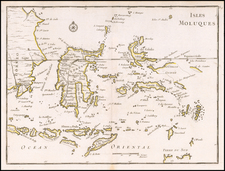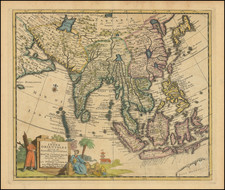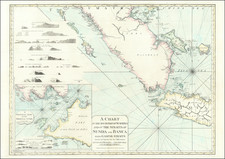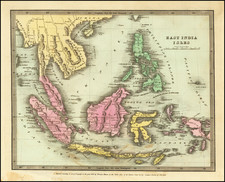Scarce engraved sea chart of the coast of Western Java and the southern tip of Sumatra, published by John Thornton.
The map includes details along the coast that suggest the firsthand surveying that went into its production. Soundings are given from harbor to harbor. Effort has been put into annotating points of interest along the coast.
The map includes some topographical features along the coastline.
Twin flags illustrate the location of Batavia (Jakarta).
The present example of the map is from the 1711 edition of Mount & Page's publication of The English Pilot, the Third Book, which was the definitive English-language sea chart book for the voyage to the East Indies when it was first introduced in the 17th century. The English Pilot The Third Book, as well as the maps from it, is very scarce on the market; the last example to appear at auction was sold for over 150,000 euros.
John Thornton (1614-1708) served as hydrographer to the Hudson Bay Company and East India Company. Thornton's two major atlas works were the Atlas Maritimus and the English Pilot in four books. The maps in these books reflected the knowledge he garnered in his respective appointments.
John Thornton was a respected and prominent chartmaker in London in the latter part of the seventeenth century. He was one of the final members of the Thames School of chartmakers and served as the hydrographer to the Hudson's Bay Company and the East India Company. He produced a large variety of printed charts, maps, and atlases in his career, but he was also a renowned manuscript chart maker. Born in London in 1641, he was apprenticed in the Drapers Company to a chartmaker, John Burston. After being made free of the company (1665), he was part of the combine that took over John Seller’ English Pilot in 1677. Thornton was trusted by the naval and navigational establishment of the day; one of his clients was Samuel Pepys, naval administrator and diarist. Thornton died in 1708, leaving his stock to his son, Samuel, who carried on the business.
Samuel, born in ca. 1665, also had apprenticed in the Drapers Company and was made free a year after his father’s death. He continued the business until 1715, when he died. His stock then passed to Richard Mount and Thomas Page.










![(First state!) [ Southeast Asia ] Tabula Asiae XI](https://storage.googleapis.com/raremaps/img/small/94616.jpg)



![[ Australia called Notasie ou Nouvelle Hollande ] Carte De L'Oceanie Contenant L'Australe, La Polynesie et Les Iles Asiatique . . . 1838](https://storage.googleapis.com/raremaps/img/small/99649.jpg)